| FRAMING TEXTILES |
 |
|
Textiles have been a part of interior decor for millennia. From the ornate tapestries woven by secluded wives awaiting their husbands to return from the Trojan war, to the stunningly intricate lacework of Irish nuns, to the quilts your grandmother gave every baby, we have loved the texture, appearance, and warmth fabrics have provided in our homes.
Today, many of these items have moved from practical to priceless, and their owners will go to great lengths to keep them safe. Framing your textile artwork is a great way to make it last for generations. The following list is just some of the materials that may be displayed using the techniques outlined in this article.
- Quilts
- Weaving
- Cultural or traditional clothing
- Needlework
- Batik dyed fabrics
- Tapestries
|
SUMMARY
This article is chock full of useful information about displaying your textile artworks.
| SHOULD YOU FRAME IT? |
FRAMELESS OPTIONS |
FRAME DECISIONS |
MOUNTING THE ART |
Four factors to help you decide:- Location
- Environmental
- Size
- Drape
|
Four frameless display ideas:- Dowel rod hanger
- Wrapped
- From the ceiling
- Draped
|
Six considerations:- Glazing
- Air gap
- Matting
- Archival
- Depth
- Style
|
Three mounting suggestions: |
|
| SHOULD YOU FRAME YOUR TEXTILE ART?
|
 |
|
Unlike paper artwork, which pretty much has to go in a frame, textile art can be displayed in a number of different ways. So the first thing you need to decide when preparing to hang textiles is whether or not the piece should be framed, and whether or not you want to!
Regarding what is best for your artwork, there are five factors to take into consideration:
- Location. Where do you plan to hang your fabric artwork? The location you have chosen should be a large factor is choosing the display style. Is it going to hang somewhere that people can reach out and touch it, or will brush by it? If so, and it's not something that can be easily washed, a frame and glazing will ensure you only need Windex to tidy it up, not a drycleaner.
- Environmental factors. This factor is really an extension of location. Any artwork hung without a protective encasement runs the risk of being damaged by natural and other airborne particles. Framing a special textile piece will protect it from bugs that might eat away at, or make a home in, it, as well as dust, dirt, and other things like cigarette smoke that might be in the air around the art.
Sunlight is another environmental concern. If you've selected a spot that is beautifully lit by the sun for eight hours of the day, then a frame with UV-protective glass or acrylic is probably a good idea. Without the glass, your artwork will fade over time, and not necessarily in a uniform way. To make matters worse, the UV radiation can also cause the fibers of the material to break down, weakening the overall structure of the artwork and greatly diminishing its lifespan.
- Size. A really large textile artwork (such as a double or queen sized quilt) may not be suitable for framing. The frame and glazing required to house such a large piece will be quite heavy. Plexiglass is lighter than glass, which can lessen the weight a little, but it is usually available in widths of no more than 4 feet. Weight of the frame itself aside, you must consider the strength of the wall and hanging hardware required to display very large framed art.
- Drape. This refers to the way your art falls when hung. Does it have waves, creases, curls, or deep undulations? The presence of these doesn't mean you can't frame your artwork, but it does mean you should consider hanging it in a different way, with or without the frame. You will most likely need a deeper frame (a shadow box) to allow those essential details to shine through.
If, after you have considered these four things, you still want to frame your textile art, you can skip right down to our Framing Your Art section. If you want to explore some other hanging options, see our next section, Frameless Mounting.
|
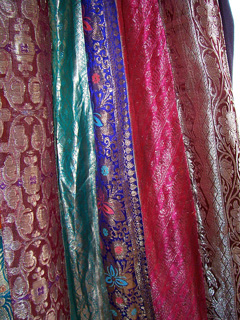
Delicate, detailed scarves should be framed
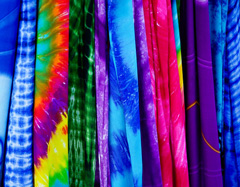
Durable, modern materials may not need to be framed
|
| FRAMELESS DISPLAYS
|
 |
If you're opting against a frame for your fabric or textile artwork, you still need to make a decision on the frameless way you will hang the piece.
DOWEL ROD HANGER
Using a wooden or plexiglass dowel to hang your artwork is a great, traditional way to let it fall just the way it was intended. However, displaying a textile piece from a dowel also requires a pocket along the top of the artwork, through which the dowel can be threaded.
Some wall hangings are made with this display style in mind, and will feature a hemmed edge, like a curtain. If this is the case, you simply need to make sure you select a dowel slender enough to fit the space.
If your artwork has no such hanger, you can add your own without interrupting or damaging the look of the piece. A tube of fabric slightly shorter than the horizontal length of the art can be carefully stitched to the top back of the piece, just below the top edge. The thread used to attach this tube should match the material, or a clear thread can be used. A dowel can then be slipped through this new pocket.
Once the dowel is threaded, you have two options for hanging your artwork. Hooks can be inserted into the wall, with the dowel resting on them on either side of the artwork. You may choose to make the dowel a few inches longer than the piece so the dowel is part of the display, or exactly the right size so the art appears to float.
Alternately, twine, ribbon, or thread can be tied to either end of the dowel, and the artwork can be hung from a hook above.
NOTE: If your textile artwork is a piece of traditional or cultural clothing and you're planning to run the dowel through the sleeves, you will want to wrap the dowel first in padding so it does not crease the material should you ever decide to wear it!
WRAPPED
Technically this option does use a frame, but it's on the inside, and doesn't require glazing!
A stretcher bar frame (used for artist's canvas), a wood or plastic panel can be used to create a frameless but rigid display for textile art. The frame or panel is first wrapped in cotton batting or soft material to prevent the edges creasing the textile. The art is then wrapped around the frame like a canvas, pinned, stitched, or stapled to the back.
Of course, this display style only works for artwork that has excess material around the outsides, or an outer edge you don't mind losing to the wrap. But it can be an artsy way to showcase the work without using a heavy frame and glass.
FROM THE CEILING
Thin, lightweight, or translucent fabrics can be hung from the ceiling to partition a room, cover a window, or simply create an eye-catching art display. Using fishing wire or twine, dangle the material from hooks or disguised pins stick into the ceiling. This isn't a look for every taste, but can be striking when properly executed.
DRAPED
If you prefer a style completely separate from the structural facets of your home, you can drape your textile art. Over the back of an antique chair, around a banister, or on a curved pedestal - this is a unique display style that probably doesn't suit every type of decor, but can result in a high fashion look.
|
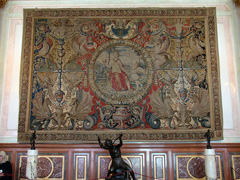
Dowel-hung tapestry
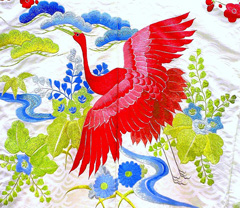
Clothing like kimonos may or may not be framed
|
| FRAMING YOUR ART
|
 |
THE FRAME
You've decided on framing, but you've only just begun the selection process. Custom picture frames come in a wide variety of style options. At KeenART Media, we offer more than 500 different picture frames that range from less than an inch in width to more than four inches. We have choices for contemporary decorators, those who like the classic gilding and gold, and anyone with a penchant for rustic decor.
There are a number of factors to consider when picking a frame for your textile art.
- Glass or Plexiglass?
We mentioned glazing options briefly above, but let's take a closer look at these two choices for protective clear covers.
Glass is the classic choice for picture framing, and it can create a beautiful, crisp view, but it does have a few drawbacks. For one, glass is often twice as heavy as acrylic glass (plexiglass). For a small frame this isn't a big deal, but many textile pieces are at least a few feet across, so your wall hanging could get heavy pretty fast, especially when you factor in the frame.
As we know, glass also shatters when it breaks. Those razor-sharp shards can rip into the material of your artwork, and small pieces can get lodged in the fabric. When plexiglass breaks, it usually just cracks, and it never shatters into small bits. For these reasons, it's a safer choice for your frame display. These days, even museums often choose acrylic over silicate (real) glass.
One instance where you might choose glass over acrylic is for a piece that is extremely delicate, or has loose pieces such as tassels. Acrylic glass creates static which can draw any unsecured bits away from the artwork, making them come loose or stick straight out.
- Space between frame and glazing.
It's strongly recommended that you create space between the glazing and the artwork. Humidity may collect on the inside of the glazing unavoidably, and if the material is in contact, the moisture will transfer and can encourage mold growth on the artwork, which will not only create an unattractive stain, but also degrade the fabric.
To keep this from happening, pick a frame that allows you at least a few millimeters of space between the art and glazing. Since frames are assembled by pressing the contents to the front of the frame (against the lip), you will need to place spacers to create this gap.
One way to create this separation is by placing a window mat between the glazing and the artwork, as you often would with paper or photographs. We will discuss matting your artwork in the next step, but right now let's just consider dedicated frame spacers.
Narrow enough to remain hidden behind the lip, frame spacers are small plastic strips that either clip around your mounted artwork and the glass, with a shelf in between to hold them apart, or are simply placed on the glass after it's set in the frame. Our Frame Spacers article is dedicated to these handy tools, so we won't go into great detail here. Suffice to say they are easy to use and work well.
Dedicated spacers are often sold in large amounts, however, and may not be practical for a single frame. Also, some styles need to be the exact size of your contents, and so can be tricky to select. At KeenART Media we offer an alternative: adhesive foam board. Available in black or white, these narrow foam strips adhere to the inside of the frame after the glazing is in place. They can be custom cut to any depth. Request them with your frame order to learn more.
- Matting your artwork.
Another option for creating that space is to use a window mat. If you prefer the edges of your artwork be hidden, or are a fan of white space within a frame, a mat is a good choice. You can choose from a variety of colors, and select whatever width you desire. Unfortunately, mats are only an option for smaller textiles, since the maximum size is 32x40".
For paper artwork, a mat provides the perfect amount of space between glass and art. If your textile is slightly thicker, however, the depth of the mat may not be enough. In this case, you have a few options:
- You can opt for frame spacers instead of a mat, and either leave white space on the mounting board around the art, or forgo this altogether.
- If you only need a tiny bit more space, you can use a thicker mat. Most mats are 4-ply, but 6- and 8-ply are also available, and can create up to 3 mm of space.
- You can use a mat and frame spacers, by either putting the spacers between the mat and the art, or between the glazing and the mat.
Browse our great selection of matboards - in three quality/price brackets - on our Matboards page.
- Archival materials?
The thicker mats mentioned above are usually "museum quality". This means they are made from 100% cotton which has no wood fiber. Wood contains lignin, an acid which can, over time, yellow or degrade your artwork. If you're still using good quality, non-archival mats and materials, "time" generally mean decades or even a century. But if you plan to present this artwork as an heirloom to be passed from generation to generation, it may be worth the extra time and money to have it framed in an archival method.
In addition to the mat, for an archival display you will also want to make sure the glazing is UV-protective (as discussed above), the mounting board is at least acid-free, or preferably another piece of that museum-grade matboard, and the thread used to mount the art is 100% cotton, too.
In addition, you will want to make sure the framer (whether that's your husband, your mom, or a professional) knows you require archival treatment of this artwork. That means wooden frames should be lined to keep the lignin from seeping into the archival contents, and any other materials - tapes, other adhesives, etc - are paper-free as well.
- Depth of the frame.
Directly related to the spacing is the depth of frame you will require for your display. Most textile art is relatively shallow - probably thicker than paper, but not by much. But unlike paper, many textiles are not intended to lay perfectly flat. How much wave or texture your artwork has will determine the thickness of the frame you need.
When considering frame depth, try to measure the depth of the artwork at the deepst point. Then factor in the glazing, the space between the glazing and the art, and the board onto which your art will be mounted. The rabbet or rebate measurement is what you are looking for - the distance between the back of the lip and the very back of the frame. It's fine if the rabbet is too deep, but it shouldn't be too shallow.
Very thin textiles may be fine in a regular picture frame with a deep rabbet of 5/8" or so. But thicker materials will likely require a shadow box frame, which may be anywhere from 3/4" to many inches deep.
Choose a shadow box frame or traditional picture frame from our vast and varied options.
- Style of the frame.
Once you've made all these hard choices that require math, you can have some fun picking out the perfect picture frame style. Your depth requirement should narrow the selection a bit, and then you'll want to choose something that complements both the artwork and the decor in the room.
Most designers will suggest you worry more about the frame matching the art than the room. You might move that piece to a different spot some day, and a little bit of contrast only adds interest. But if you pair a starkly contemporary textile with an ornate gilded frame - or vice versa - the frame could end up stealing attention from the artwork.
See some ornate gold frames here. Or check out some modern frame mouldings here.
|
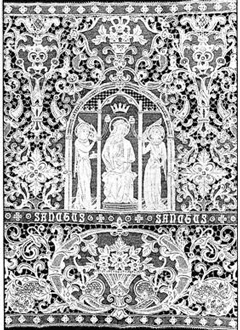
Lacework should usually be framed.
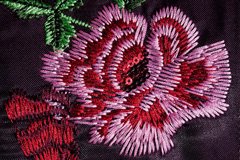
Embroidery is often framed
|
| MOUNTING THE ARTWORK
|
 |
|
Your artwork will most likely need to be mounted to a rigid board before you're able to frame it - with the exception of felt or quilting squares that can be placed directly into a frame of the exact size.
Your mounting board will ideally be a material that is hard, but can be punctured easily. Foam core (also called foam board) is an excellent choice. It is available in acid-free for a more conservative option. Cardboard is a poor choice due to the high level of acids that will damage and discolor your artwork very quickly.
STITCHING
Placing a thin stitch around the edge of the textile is one of the best ways to mount your artwork. If you are using a mat, your mounting board will be larger than the artwork so it fits the frame. Otherwise, your mounting board may be the same size as the artwork. Either way, you can place small holes (using a needle or nail) around the foam board at regular intervals (about 1/2", depending on the total size) and then stitch the artwork to the board through these holes, using matching or clear thread.
As long as you keep your stitches as close to the edge of the artwork as possible, they will probably be hidden behind the mat or frame lip. If you are leaving the mounting board visible between the art and the frame, it will be extremely difficult to see the stitches.
PINNING
A quicker option, though one more difficult to conceal, is to use small pins along the edge, which are simply pressed through both the material and the foam board. You may want to use long pins that can easily be bent at the back so they lie flat against the back of the mounting board.
If you choose this option, be sure you use good quality, stainless steel or coated pins. Otherwise, you may find they rust and stain your artwork if they come into contact with any moisture.
WRAPPING
In the frameless display options, we discussed wrapping the artwork around a board. You can follow this same method for framing. Cut a mounting board (foam board is still a good choice) the same size as the frame opening, minus a few millimeters to allow for the material. Then wrap the artwork around the board and fasten it to the back with acid-free linen tape (that won't ruin the material) or just another board pressed firmly on top. Place the entire contents into the frame (with or without glass - and if you use glass, don't forget the spacers!), and seal the back!
You can find a happy medium between the frameless wrapping and a picture frame, too. After you've wrapped the art as described in the Frameless Displays section, place the artwork in a canvas floater frame for a simple style that doesn't overlap the edges of your beautiful art.
DOWEL ROD
Finally, you may choose to hang your artwork with a dowel rod, as discussed above, but within a frame. The ends of the dowel (where they would rest on hooks in the wall) can be securely stitched to the mounting board, and you may choose to stitch or pin down the ends of the material as well. This is a great option for cultural clothing items that are too delicate to be hung without glass.
|
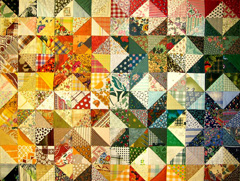
Quilts can be stitched to the mounting board
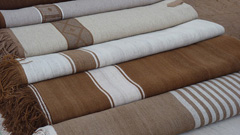
An Andean poncho could be hung framed or unframed
|
|
However you decide to display your textile artwork, it is sure to be a beautiful addition to your existing decor. At KeenART Media we offer a wide range of frames for all your picture framing needs, and each order comes complete with the hanging hardware you'll need to display your artwork right away.
If you have questions about the best frame for your art piece, or any of our other services or products, don't hesitate to contact us. Our knowledgeable staff is always happy to assist with answers, advice, or suggestions.
|
|
© 2002-2025 - KeenART Media Ltd.
|
|
| |
|

